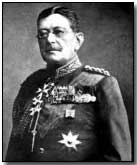Who's Who - Baron von der Goltz
 Wilhelm Leopold Colmar, Baron
von der Goltz (1843-1916) served as commander in chief of Turkish forces in
Mesopotamia and successfully conducted the
siege of the Anglo-Indian force
in Kut.
Wilhelm Leopold Colmar, Baron
von der Goltz (1843-1916) served as commander in chief of Turkish forces in
Mesopotamia and successfully conducted the
siege of the Anglo-Indian force
in Kut.
Born on 12 August 1843 near Labiau in East Prussia Goltz joined the German army in 1861. In a widely varied career Goltz served as soldier, military lecturer (at Berlin from 1878-83) and writer (publishing The Nation in Arms in 1883) before becoming, in June 1883, military advisor to the Turkish army while still a Major.
Tasked with the modernisation of the Turkish army Goltz was so successful that it required the intervention of the major European powers to call a halt to the Greco-Turkish War of 1897 which Turkish forces appeared to be on the verge of winning.
Having returned to Germany in 1897 as a Lieutenant General Goltz next saw significant service with the outbreak of war in August 1914 - having been made Field Marshal in 1911 following further service in Turkey - when he was appointed military governor of Belgium following its seizure by the German army.
Deeply dissatisfied with this role - he had no appetite for oppressing the civilian populace - Goltz was consequently relieved to be despatched back to Turkey in November 1914, becoming aide-de-camp to Sultan Mehmed V.
Handed command of the Turkish First (Bosporus) Army in Mesopotamia (present day Iraq) following a power struggle with Liman von Saunders, Goltz proved unpopular with Turkish War Minister Enver Pasha. Goltz's plans for a large-scale attack upon the British in Egypt or India therefore found little favour. He was subsequently appointed to command of Sixth Army in October 1915, heralding a much-desired return to regular soldering.
Goltz successfully halted Sir Charles Townshend's Anglo-Indian army among the ancient ruins of Ctesiphon on 22 November 1915. The following month, on 8 December, Goltz followed up this success by penning Townshend's force at Kut. Having then repulsed the large British force despatched to relieve Townshend Goltz conducted the 143-day siege of Kut which finally ended with Townshend's surrender on 29 April 1916.
However Goltz never lived to savour his victory: he died ten days earlier of Typhus, although rumours persisted (unproven) that he was actually poisoned by a group of Young Turk officers.
An Adrian Helmet was a French regulation helmet named after its designer.
- Did you know?
